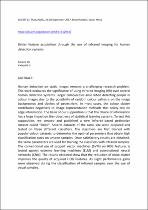 ResearchSpace
ResearchSpace
Better feature acquisition through the use of infrared imaging for human detection systems
JavaScript is disabled for your browser. Some features of this site may not work without it.
- ResearchSpace
- →
- Research Publications/Outputs
- →
- Conference Publications
- →
- View Item
| dc.contributor.author |
Kunene, Dumisani C

|
|
| dc.contributor.author |
Vadapalli, H

|
|
| dc.date.accessioned | 2017-11-16T07:25:48Z | |
| dc.date.available | 2017-11-16T07:25:48Z | |
| dc.date.issued | 2017-09 | |
| dc.identifier.citation | Kunene, D.C. and Vadapalli, H. 2017. Better feature acquisition through the use of infrared imaging for human detection systems. SAICSIT 17, Thaba Nchu, 26-28 September 2017, Bloemfontein, South Africa | en_US |
| dc.identifier.isbn | 978-1-4503-5250-5 | |
| dc.identifier.uri | https://dl.acm.org/citation.cfm?id=3129437 | |
| dc.identifier.uri | http://hdl.handle.net/10204/9787 | |
| dc.description | Copyright: 2017 ACM. Due to copyright restrictions, the attached PDF file only contains the abstract of the full text item. For access to the full text item, please consult the publisher's website. | en_US |
| dc.description.abstract | Human detection on static images remains a challenging research problem. This work evaluates the significance of using infrared imaging (IIR) over several human detection systems. Larger complexities arise when detecting people in colour images due to the possibility of random colour patterns on the image backgrounds and clothes of pedestrians. In most cases, the colour clutter contributes negatively to image representation methods that solely rely on edge information. The basis of our supposition is that the choice of information has a large impact on the robustness of statistical learning systems. To test this supposition, we created and published a new infrared-based pedestrian dataset called “SIGNI". Several datasets of the same size were prepared and tested on three different classifiers. The classifiers are first trained with popular colour datasets to determine the optimal parameters that obtain high classification rates on unseen samples. Once satisfactory results are obtained, the same parameters are used for training the classifiers with infrared samples. The conventional use of support vector machines (SVM) on HOG features is tested against extreme learning machines (ELM) and convolutional neural networks (CNN). The results obtained show that the reduction of noise clutter improves the quality of acquired HOG features. As slight performance gains were observed during the classification of infrared samples over the use of visual samples. | en_US |
| dc.language.iso | en | en_US |
| dc.publisher | ACM Digital Library | en_US |
| dc.relation.ispartofseries | Worklist;19732 | |
| dc.subject | Human detection | en_US |
| dc.subject | Feature extraction | en_US |
| dc.subject | Noise-reduction | en_US |
| dc.subject | Support vector machines | en_US |
| dc.subject | Extreme learning machines | en_US |
| dc.subject | Convolutional neural networks | en_US |
| dc.subject | Infrared imaging | en_US |
| dc.title | Better feature acquisition through the use of infrared imaging for human detection systems | en_US |
| dc.type | Conference Presentation | en_US |
| dc.identifier.apacitation | Kunene, D. C., & Vadapalli, H. (2017). Better feature acquisition through the use of infrared imaging for human detection systems. ACM Digital Library. http://hdl.handle.net/10204/9787 | en_ZA |
| dc.identifier.chicagocitation | Kunene, Dumisani C, and H Vadapalli. "Better feature acquisition through the use of infrared imaging for human detection systems." (2017): http://hdl.handle.net/10204/9787 | en_ZA |
| dc.identifier.vancouvercitation | Kunene DC, Vadapalli H, Better feature acquisition through the use of infrared imaging for human detection systems; ACM Digital Library; 2017. http://hdl.handle.net/10204/9787 . | en_ZA |
| dc.identifier.ris | TY - Conference Presentation AU - Kunene, Dumisani C AU - Vadapalli, H AB - Human detection on static images remains a challenging research problem. This work evaluates the significance of using infrared imaging (IIR) over several human detection systems. Larger complexities arise when detecting people in colour images due to the possibility of random colour patterns on the image backgrounds and clothes of pedestrians. In most cases, the colour clutter contributes negatively to image representation methods that solely rely on edge information. The basis of our supposition is that the choice of information has a large impact on the robustness of statistical learning systems. To test this supposition, we created and published a new infrared-based pedestrian dataset called “SIGNI". Several datasets of the same size were prepared and tested on three different classifiers. The classifiers are first trained with popular colour datasets to determine the optimal parameters that obtain high classification rates on unseen samples. Once satisfactory results are obtained, the same parameters are used for training the classifiers with infrared samples. The conventional use of support vector machines (SVM) on HOG features is tested against extreme learning machines (ELM) and convolutional neural networks (CNN). The results obtained show that the reduction of noise clutter improves the quality of acquired HOG features. As slight performance gains were observed during the classification of infrared samples over the use of visual samples. DA - 2017-09 DB - ResearchSpace DP - CSIR KW - Human detection KW - Feature extraction KW - Noise-reduction KW - Support vector machines KW - Extreme learning machines KW - Convolutional neural networks KW - Infrared imaging LK - https://researchspace.csir.co.za PY - 2017 SM - 978-1-4503-5250-5 T1 - Better feature acquisition through the use of infrared imaging for human detection systems TI - Better feature acquisition through the use of infrared imaging for human detection systems UR - http://hdl.handle.net/10204/9787 ER - | en_ZA |





